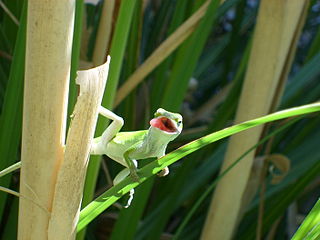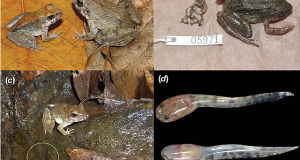I’ve been fascinated by Green Anoles, Anolis carolinensis, since childhood – way back when they were sold as “American Chameleons”. Although they are often ignored by experienced keepers, I have long featured Green Anoles and related species in zoo exhibits, where they never failed to intrigue visitors (and yours truly!). Now, it seems, they are also impressing herpetologists with learning abilities that rival those of some birds. The performances of anoles (two of which did so well that they were dubbed “Plato” and ‘Socrates”) tested at Duke University have challenged the stereotype that small lizards have limited intelligence and problem-solving abilities.
Learning, Adapting and Remembering…
The species studied was the Emerald or Puerto Rican Anole, Anolis evermanni. It seems likely that Green Anoles and others sharing similar lifestyles will be found to possess like abilities; further research is in progress.
The anoles were presented with a problem that would not be faced in the wild…relying upon instinct would not provide a solution. The challenge presented was to retrieve an insect that had been placed beneath a plastic lid. Emerald Anoles figured out how to lift the lid more quickly than did the birds that were tested, requiring three less trials. What’s more, the anoles had only one test each day, compared to the given the birds, so the lizards had less experience, and needed to remember their successes or failures for a longer period of time.
When multiple caps of different colors were added, the savvy anoles always chose the correct cap, apparently having associated the color or brightness with a reward. The researchers then switched tactics, placing the insect beneath a lid of a different color, and leaving the original correct choice bare. All of the anoles made initial mistakes, but ‘Socrates” and “Plato”, the individuals mentioned earlier, quickly learned to ignore their earlier lesson and consistently chose the correct lid.
Intelligent Reptiles: Anoles, Monitors, Tortoises and Others
Problem solving, and the ability to modify or discard what has been learned if needed, is considered to be an important indication of intelligence. Some herpetologists believe that anoles are quick learners because they evolved in complex environments occupied by insects that are difficult to capture. Mental acuity may partially explain the phenomenal success of this group, and the huge number of species (391 at last count) that now exist.
But the existence of intelligent reptiles comes as no surprise to those of us who keep and study them…Red-Footed Tortoises learn to negotiate mazes by imitation, and monitors seem capable of outright “plotting”! I’ve been amazed, again and again, by a number of species. Please see the articles linked below to read about examples drawn from observations of captive and wild reptiles.
Anoles in Captivity
Anoles are widely considered as “beginner’s lizards”, but this does them a great disservice…even the hardiest hold secrets that we have yet to uncover. Most are relatively small, allowing one to observe group interactions in well-planted terrariums. Others, such as the majestic Knight Anole, Anolis equestris (please see photo), approach 2 feet in length and are capable of downing small birds and snakes. All are fascinating to know. Please see this article for information on their care, and be sure to post your questions and observations below.
Further Reading
Red-Footed Tortoises Learn by Imitation
 That Reptile Blog – Reptile, Amphibian and Exotic Pet Care and Information
That Reptile Blog – Reptile, Amphibian and Exotic Pet Care and Information





This was a fun read! I’m sure that we don’t give animals in general enough credit when it comes to intelligence. It takes brains to be able to survive in the wild!
Great post!
Much appreciated,
best regards, Frank
Great article Frank I love watching the cuban brown anoles living their little lizard lives outside in my yard.
Thanks very much. It’s great to have small, territorial lizards close at hand, as even by casual observation we can learn a great deal about their lives. Archie Carr, renowned herpetologist, accomplished much in this manner at his home in Fla. Fla is a great place to study introduced anoles…unfortunately, the Brown has largely displaced the native Green, but much of interest to be seen none-the-less. You can read more about this species and Fla’s other 9-10 introduced anoles (and other exotics) here.
Enjoy, Frank
I so enjoy reading your articles! You are the sole reason(in a round about way) I’m getting a reptile in middle age:) I ‘reptile sat’ on because the person got me interested in her pets from articles you wrote.I never would have watched her pets had I not had faith in myself to do so.I read your info and now Im’adopting’ You are a wonderful teacher and truly what the reptile world should be made up of…interesting,intelligent people,who give the hobby a great name.I know many others are thankful for all your wonderful info!Warmest Regards!Teresa
Hello Teresa,
Wow…I hope I can live up to your kind words….much appreciated! Please keep me posted on your activities and let me know if I can be of any help.
Enjoy, Frank
Hi Frank,
Have you read the study about learning by immitation in bearded dragons?
http://link.springer.com/article/10.1007%2Fs10071-014-0803-7#page-1
There were two groups of bearded dragons (Pogona vitticeps), the one had a conspecific who knew to open a trapdoor to get food, to the other the door was opened by the experimenters, and the animals could not see it. Animals exposed to the one which learnt to open the door figured it out themselves as well, while the others did not.
Great info, thanks..we have seen the same in tortoises and “even” goldfishes (fish experiment involved hidden food). Best, Frank